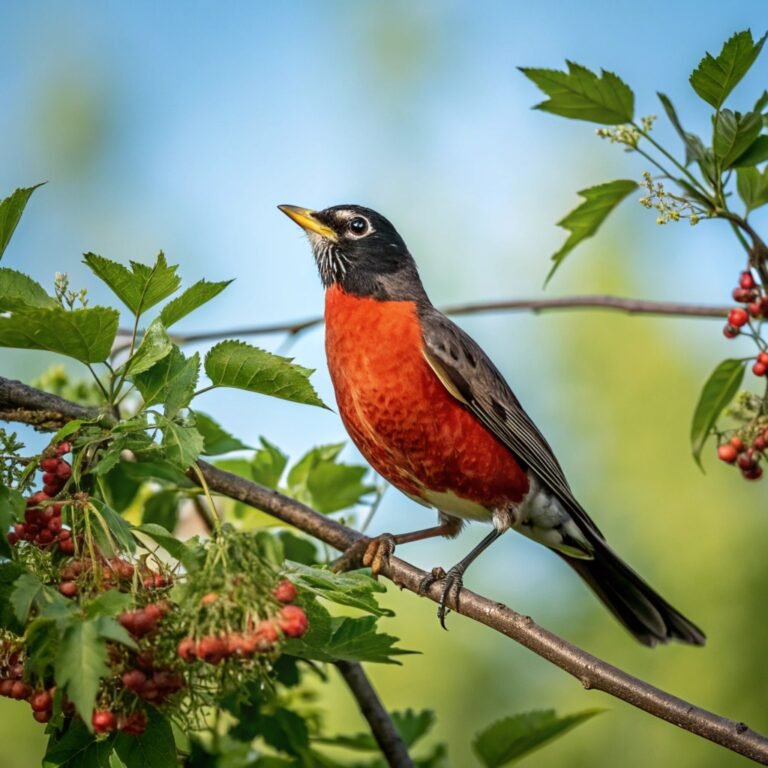11 Owls of Ohio: A Comprehensive Guide to These Powerful, Majestic, and Nocturnal Birds of Prey
Ohio’s diverse landscapes provide ideal habitats for a variety of owls species, making it a haven for these fascinating nocturnal birds of prey.
From the dense forests to open farmlands, the Buckeye State is home to several owl species that captivate both seasoned birders and casual nature enthusiasts alike.
This comprehensive guide will explore the 11 owl species found in Ohio, their unique characteristics, habitats, and behaviors.
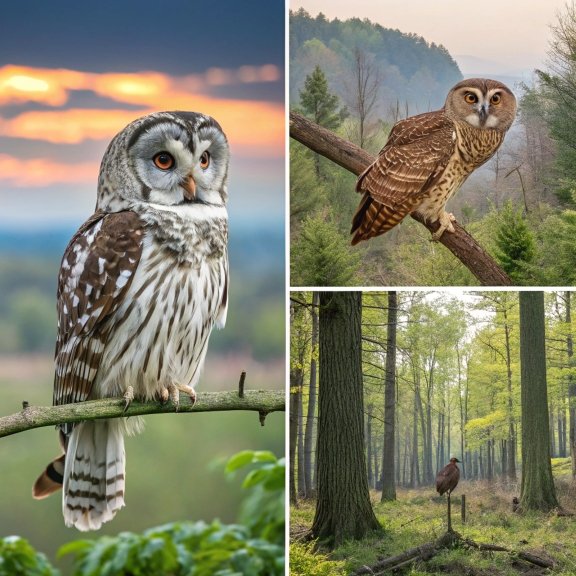
Key Takeaways:
- Ohio is home to 11 owl species, ranging from common residents to rare visitors
- The most common owls in Ohio include the Eastern Screech-Owl, Great Horned Owl, and Barred Owl
- Owl species in Ohio vary in size from the tiny Northern Saw-whet Owl to the large Great Horned Owl
- Some owls, like the Snowy Owl, are rare winter visitors to Ohio
- Owls play a crucial role in Ohio’s ecosystems as efficient predators of small mammals and other prey
- Many owl species in Ohio face challenges due to habitat loss and human disturbance
- Conservation efforts and nest box programs have helped some owl populations recover in Ohio
- Owls can be found in various habitats across Ohio, including forests, grasslands, and urban areas
- Some owl species, like the Barn Owl, are listed as threatened in Ohio and require special protection
- Owls have unique adaptations, such as silent flight and exceptional hearing, that make them effective hunters
- Responsible owl watching practices are essential to minimize disturbance to these sensitive birds
The Eastern Screech-Owl: Ohio’s Diminutive Woodland Resident
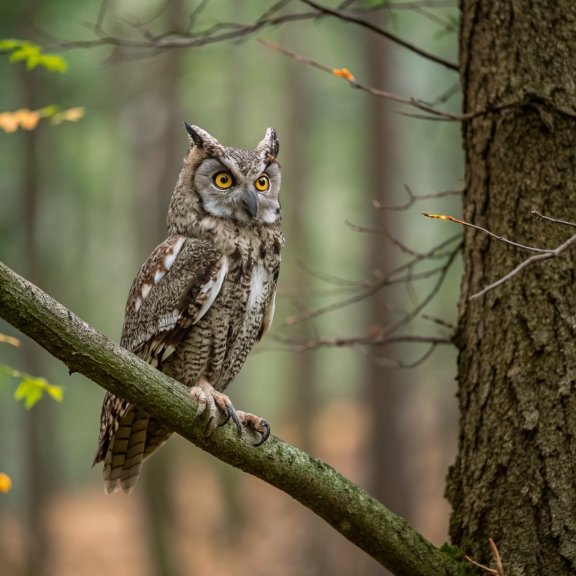
The Eastern Screech-Owl (Megascops asio) is one of the most common owl species in Ohio. These small owls, measuring only 16 to 25 cm in length, are masters of camouflage with their mottled gray or reddish-brown plumage.
Eastern Screech-Owls are adaptable and can be found in a variety of wooded habitats, including urban parks and suburban areas. Their distinctive trilling call is often heard at night, though it doesn’t resemble a screech at all.
These owls are cavity nesters, often using old woodpecker holes or nest boxes. Their diet consists mainly of small rodents, insects, and occasionally small birds.
Despite their small size, Eastern Screech-Owls are fierce predators and play an important role in controlling rodent populations in Ohio’s ecosystems.
The Great Horned Owl: Ohio’s Powerful Nocturnal Hunter
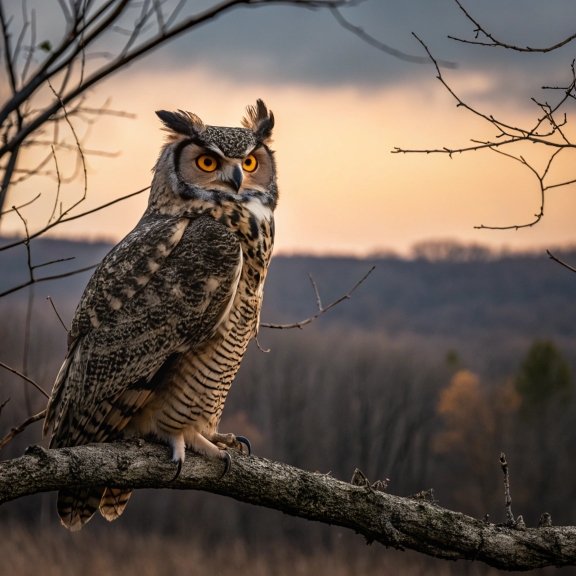
The Great Horned Owl (Bubo virginianus) is the largest resident owl species in Ohio, with a length of 21-23 inches and an impressive wingspan of up to 5 feet. These powerful predators are easily recognized by their large size, prominent ear tufts, and distinctive “hoo-hoo-hoo” call.
Great Horned Owls are found throughout Ohio in a variety of habitats, from forests to open farmlands with scattered woodlots. They are early nesters, often beginning their breeding season in late winter.
These owls don’t build their own nests but instead take over abandoned nests of other large birds or use tree cavities.
Great Horned Owls are apex predators in Ohio’s ecosystems, feeding on a wide range of prey including small mammals, birds, and even other owls.
Their adaptability and hunting prowess have allowed them to thrive in both rural and urban environments across the state.
The Barn Owl: Ohio’s Ghostly Agricultural Ally

The Barn Owl (Tyto furcata) is a distinctive species with its heart-shaped face and pale, ghostly appearance. Once common in Ohio, Barn Owl populations declined significantly in the mid-20th century due to habitat loss and changes in agricultural practices.
However, conservation efforts and nest box programs have helped this species recover in recent years. Barn Owls prefer open habitats such as grasslands, meadows, and agricultural areas. They are cavity nesters, often using old barns, silos, and other structures for nesting.
These owls are highly efficient hunters, with specialized hearing that allows them to locate prey in complete darkness. Their diet consists primarily of small rodents, making them valuable allies for farmers in controlling pest populations.
Despite recent population increases, Barn Owls remain listed as threatened in Ohio, highlighting the importance of ongoing conservation efforts.
The Barred Owl: Ohio’s Vocal Forest Dweller

The Barred Owl (Strix varia) is a medium-sized owl known for its distinctive “who-cooks-for-you” call. These owls are common residents in Ohio’s mature forests, particularly in areas with large deciduous trees and nearby water sources.
Barred Owls have rounded heads without ear tufts and dark eyes, setting them apart from other large owl species in the state.
They are cavity nesters, often using natural tree hollows or abandoned nests of other large birds. Barred Owls are opportunistic hunters, feeding on a variety of small mammals, birds, amphibians, and even fish.
Their populations in Ohio have increased in recent decades as forests have matured and expanded. These owls are relatively tolerant of human presence and can sometimes be found in suburban areas with sufficient tree cover.
Their vocal nature and tendency to call during the day make them one of the easier owl species to locate and observe in Ohio.
The Short-eared Owl: Ohio’s Grassland Hunter
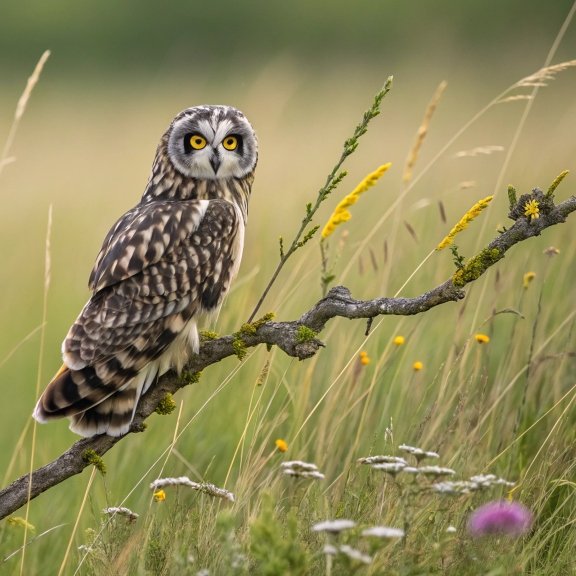
The Short-eared Owl (Asio flammeus) is a medium-sized owl that frequents open habitats in Ohio, particularly during the winter months. Unlike many owl species, Short-eared Owls are often active during daylight hours, especially at dawn and dusk.
These owls have a distinctive flight pattern, with slow, moth-like wingbeats as they hunt over grasslands and marshes. Short-eared Owls nest on the ground in areas with tall grass or other dense vegetation.
Their diet consists primarily of small mammals, particularly voles. In Ohio, Short-eared Owls are more common during winter when their numbers are bolstered by migrants from northern breeding grounds. However, small breeding populations do exist in suitable habitats across the state.
The preservation of large, open grasslands and wetlands is crucial for the conservation of this species in Ohio.
The Long-eared Owl: Ohio’s Elusive Forest Dweller

The Long-eared Owl (Asio otus) is one of the more elusive owl species in Ohio. These medium-sized owls are named for their prominent ear tufts, which are actually feathers and not ears at all. Long-eared Owls prefer dense coniferous or mixed forests for roosting and nesting.
They are strictly nocturnal and are rarely seen during the day, making them challenging to observe. In Ohio, Long-eared Owls are primarily winter residents, although small breeding populations exist in suitable habitats.
These owls are communal roosters, often gathering in small groups during the winter months. Their diet consists mainly of small mammals, particularly voles and mice.
Long-eared Owls are silent flyers, thanks to specialized feathers that muffle the sound of their wingbeats. This adaptation, combined with their excellent hearing, makes them highly effective nocturnal hunters in Ohio’s forests.
The Northern Saw-whet Owl: Ohio’s Tiny Forest Gem
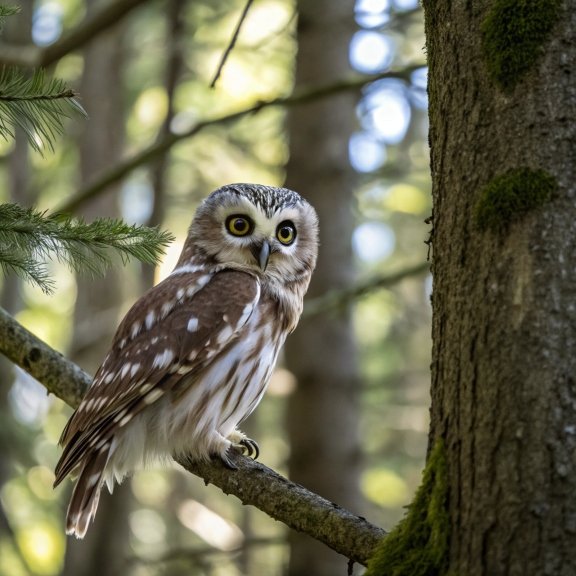
The Northern Saw-whet Owl (Aegolius acadicus) is the smallest owl species found in Ohio, measuring only 7-8 inches in length. These diminutive owls are named for their call, which resembles the sound of a saw being sharpened on a whetstone.
Northern Saw-whet Owls prefer dense coniferous or mixed forests, particularly those with a thick understory. In Ohio, they are more common during winter months when migrants from northern breeding grounds join the state’s small resident population.
These owls are cavity nesters, often using old woodpecker holes or nest boxes. Despite their small size, Northern Saw-whet Owls are fierce predators, primarily feeding on small mammals like mice and voles.
Their small size and nocturnal habits make them challenging to spot, but patient observers may be rewarded with a glimpse of these charming little owls in Ohio’s forests.
The Snowy Owl: Ohio’s Majestic Winter Visitor
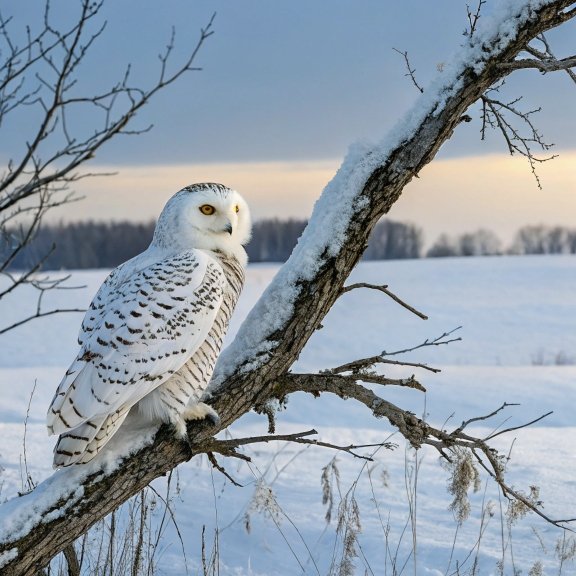
The Snowy Owl (Bubo scandiacus) is a rare but spectacular winter visitor to Ohio. These large, white owls breed in the Arctic tundra and occasionally venture south into Ohio during winter months, particularly along the Lake Erie shoreline.
Snowy Owls are diurnal, often active during daylight hours, which makes them easier to observe than many other owl species. In Ohio, they prefer open habitats that resemble their Arctic breeding grounds, such as large fields, beaches, and airports.
Snowy Owl irruptions, or large southward movements, are typically associated with fluctuations in lemming populations in their northern breeding range.
While Snowy Owl sightings in Ohio have become less frequent in recent decades, the appearance of these magnificent birds still causes excitement among birders and nature enthusiasts.
When observing Snowy Owls, it’s crucial to maintain a respectful distance to avoid disturbing these stressed winter visitors.
The Burrowing Owl: Ohio’s Rare Ground-Dwelling Visitor
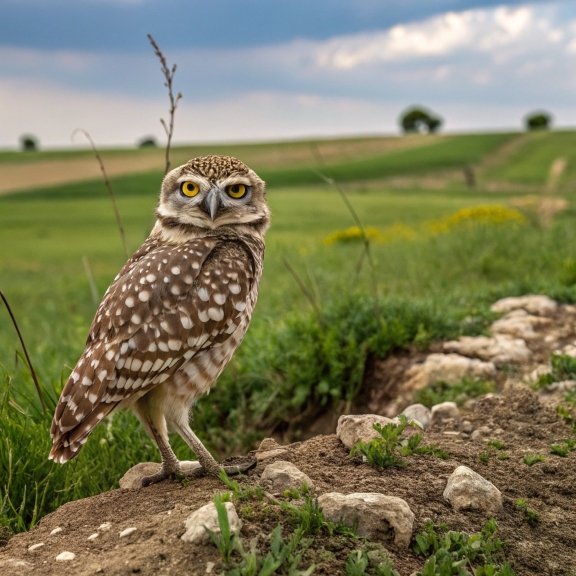
The Burrowing Owl (Athene cunicularia) is an extremely rare visitor to Ohio, with only a handful of confirmed sightings in the state’s history. Unlike most owl species, Burrowing Owls are active during the day and nest in underground burrows.
These small owls typically inhabit open grasslands and prairies in western North America, making their appearance in Ohio highly unusual. When Burrowing Owls do show up in the state, they tend to be found in open areas such as airports or large fields.
These owls have long legs adapted for running on the ground, and they often perch on fence posts or other low structures.
While Burrowing Owls are not regular residents or migrants in Ohio, their rare appearances highlight the importance of preserving diverse habitats that can support a wide range of bird species, including unexpected visitors.
The Barn Owl: Ohio’s Threatened Ghost of the Night

The Barn Owl (Tyto alba) is a species of special concern in Ohio, currently listed as threatened by the Ohio Division of Wildlife. These medium-sized owls are easily recognized by their heart-shaped facial disks and pale coloration, which has earned them the nickname “ghost owl.”
Barn Owls were once common in Ohio, but their populations declined sharply in the mid-20th century due to habitat loss and changes in agricultural practices. Today, conservation efforts, including nest box programs, have helped Barn Owl populations recover in parts of the state.
These owls prefer open habitats such as grasslands, meadows, and agricultural areas. They are highly adapted for hunting small mammals, with exceptional hearing that allows them to locate prey in complete darkness.
Barn Owls play a crucial role in controlling rodent populations, making them valuable allies for farmers. Ongoing conservation efforts are essential to ensure the continued recovery of this threatened species in Ohio.
FAQs
What is the most common owl in Ohio?
The Eastern Screech-Owl is generally considered the most common owl species in Ohio. These small owls are adaptable and can be found in a variety of wooded habitats, including urban and suburban areas.
Are there any endangered owl species in Ohio?
While no owl species are currently listed as endangered in Ohio, the Barn Owl is classified as threatened. Several other species, such as the Short-eared Owl, are considered species of concern due to habitat loss and other factors.
When is the best time to observe owls in Ohio?
Many owl species are most active at dawn and dusk. However, the best time can vary depending on the species. For example, Barred Owls may be active during the day, while Great Horned Owls are strictly nocturnal.
Where are the best places to see owls in Ohio?
Some of the best places to observe owls in Ohio include Magee Marsh Wildlife Area, Hocking Hills State Park, and Killbuck Marsh Wildlife Area. However, owls can be found in suitable habitats throughout the state.
How can I attract owls to my property?
To attract owls, you can provide suitable habitat by preserving mature trees, installing nest boxes, and maintaining areas of natural vegetation. However, it’s important to avoid using rodenticides, which can harm owls that prey on affected rodents.
What should I do if I find an injured owl?
If you find an injured owl, it’s best to contact a licensed wildlife rehabilitator or the Ohio Division of Wildlife for assistance. Do not attempt to handle or care for the owl yourself, as this can be dangerous for both you and the bird.

Hello, I’m Emily Price, the founder of Birds Affection. As a passionate bird enthusiast and spiritual seeker, I’ve always been fascinated by the symbolic meanings and mystical connections between birds and our lives. On this website, I share my knowledge and insights on the spiritual significance of various bird species, exploring their roles as messengers, guides, and teachers. Through my writing, I aim to inspire and educate others on the profound wisdom and beauty that birds bring to our world. Join me on this journey as we delve into the enchanting realm of bird symbolism and discover the hidden meanings behind these magnificent creatures.


